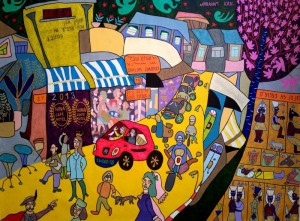אברהם קאן- ג'ונגל עירוני: תערוכה חדשה
מאת: חנה קומן
פתיחה: יום ה', ה-24 בדצמבר 2015 , גלריה ברנרד
בתערוכת היחיד הרביעית שלו בורא אברהם קאן בשתי סדרות של ציורים נאיביים אך מפוכחים, עולם אורבני סוער וגועש בהשראת רחובות תל אביב.
בסדרה אחת מהשתיים המוצגות בתערוכה, משמשים צמחיה צפופה וסבוכה, חיות פרא הלוגמות משלולית וגם משחרות לטרף, קופים מרקדים וחיות קטנות המתרוצצות במעבה היער, כהתרחשות סימבולית לזוגיות. בצבעים עזים ובקווים מדויקים, בצפיפות דחוסה של דימויים שוזר קאן סצנות מחיי נישואין. האהבה והמחלוקת, האידיליה והאי שקט, הסודות והקסמים הם מסע בעיבורו של ג'ונגל סואן, שובב וחם מזג.
בסדרת הציורים השנייה מעתיק קאן את עולם החי והצומח את הסערה וההתרחשות בו אל ליבה של העיר. רחובות אלנבי ושבזי, קינג ג'ורג' ושינקין, יפת ושדרות רוטשילד וגם כיכר מגן דוד מהווים מצע לתיאור הג'ונגל האנושי ומרחיב את מה שהחל בסדרה הראשונה.
איש מטייל עם נחש, אישה עם אריה, נמר עם כבש, מקהלת נשים ומשפחות זועקות, עכברים ענוגים, לביאות טורפות וחתולים אכזריים מתרוצצים ליד זמרת ששרה הן מקבץ של סצנות מדומיינות בתוך רחובות מוכרים. קאן עוזר לצופה להתמצא בתל אביב, הוא קורא לרחובות בשמם ומדייק בפרטי הארכיטקטורה והגיאוגרפיה שלהם. עירוב המוכר עם ההזוי הופך את ציוריו למשל על הקיום. התום שאפיין את עבודותיו הקודמות הופך למפוכח, מרחם ומקבל. סגנונו הנאיבי מאפשר לו ליצור מהעיר ההומה גן תענוגות אכזרי ולהניח במרכז הפריים את הטוב והרע, את הסבל והאהבה, את הפראי והמתורבת, את היפה והחיה, בלי לנקוט עמדה מוסרית או ערכית. קאן, שנראה שגם טולסטוי היה מסכים "שמלכות אלוהים שוכנת בתוכו"* מצייר את תל אביב כגן עדן למתבונן האנושי.
"אנשים שהיו עוברים את רחוב הרצל בלילה, היו שוקעים במחשבות של עשיית חשבון נפש. הרחוב לא היה קצר מדי כדי שלא יספיק להתרכז; והוא לא היה ארוך מדי, כדי להטיל שעמום. איך להגיד? – תל אביב היתה בדיוק בגודל הדרוש כדי להנביט בלבבות מחשבות ועשיית סיכומים. נדמה לי שזהו סודם של רחובות תל אביב עוד היום. כשפוסעים בהם (ולא כולם יפים ולא כולם מעניינים) בלילה, מתפרשים לפני כל אדם יריעות מחשבה שלו. מין יומן אישי שנמצא ברשות הרבים. עכשיו כבר תבינו איך אפשר לאהוב את תל אביב למרות שהיא גם – – לא יפה?" (נחום גוטמן, "שביל קליפות התפוזים – הרפתקאות מראשית ימי תל אביב", 1958(
בדומה לנחום גוטמן בציורי תל אביב שלו ובעיקר בסיפורי תל אביב שלו, קאן משוטט ומסתכל, בקטעים מרחובותיה, בפינות, מנציח אותה, שר לה שיר אהבה צבעוני ומסעיר. תל אביב, ההשראה, שבשמיה זורחת לבנה כחולה ולפעמים אדומה ומככבים בה מלאכים ושטן.
- *שם ספרו של לב טולסטוי "מלכות אלוהים שוכנת בתוכך" לקוח מתוך הבשורה על פי לוקאס.
Avraham Kahn – Urban Jungle
By: Hana Coman
December 2015, Bernard Gallery
In his fourth solo exhibition, Avraham Kahn creates through two series of naïve yet sober paintings, a tempestuous stormy world inspired by the streets of Tel-Aviv.
In one of the series presented in the exhibition, thick dense undergrowth, stalking wild beasts gulping from puddles, dancing monkeys and tiny animals scurrying in the thicket, function as metaphors of intimacy.
Using fierce colors and accurate strokes, in crowded, dense imagery, Kahn weaves scenes from matrimonial life. The love and the controversy, the idyllic and the unrest, the secrets and the magic, are a journey in the heart of a tumultuous jungle, mischievous and hot tempered.
In the second series, Kahn transports the fauna and flora, the tempest and its happening into the heart of the city. Allenby and Shabazi, King George and Shenkin, Yefet and Rothschild Boulevard, as well as Magen David circle, serve as foundation for the portrait of the human jungle and expands what was started in the first series.
Man strolling with a snake, woman with a lion, tiger with sheep, women’s choir and wailing families, delicate mice, devouring lionesses and cruel cats roaming near a chanting singer are a cluster of imagined scenes in familiar streets. Kahn helps the spectator to orient in Tel-Aviv, calls the streets by their names and is truthful with their geography and architectural details. By blending the familiar with the hallucinatory, his paintings become metaphors of being. The innocence that characterized his previous work becomes sober, compassionate and accepting. His naïve style enables him to create from the bustling city a cruel garden of pleasure and place mid-frame good and evil, suffering and love, the wild and cultured, beauty and the beast, without taking a moral or judgmental stance. Kahn, about whom even Tolstoy would agree, “the kingdom of god lies within*” draws Tel-Avis as a paradise for the human observer.
“People who crossed Herzl Street at night, were deep in introspection. The street was not too short for them to concentrate nor was it too long, to be boring. How shall we say it? – Tel-Aviv was just the right size required to sprout in the hearts thoughts and self-examination. This seems to be the secret of Tel-Aviv’s streets to this day. When you stroll along them (and not all are beautiful and not all are interesting) at night, individual sheets of thought spread in front of everyone. Sort of a personal diary found in the public realm. Now you’ll understand how you can love Tel-Aviv even though it’s also—not beautiful?” (Nachum Gutman, “Path of Orange Peels – Adventures in the Early Days of Tel Aviv”, 1958)
Like Nachum Gutman in his Tel-Aviv paintings and particularly in his Tel-Aviv stories, Kahn loiters and observes fragments of its streets, corners, immortalizes it, and sings her a colorful exciting love song. Tel-Aviv, the inspiration, occasionally with a blue moon shining in its sky, occasionally red, with angels and Satan occasionally staring in it.
*The name of Tolstoy’s book “The Kingdom of God Is Within You” is from Luke 17:21.

